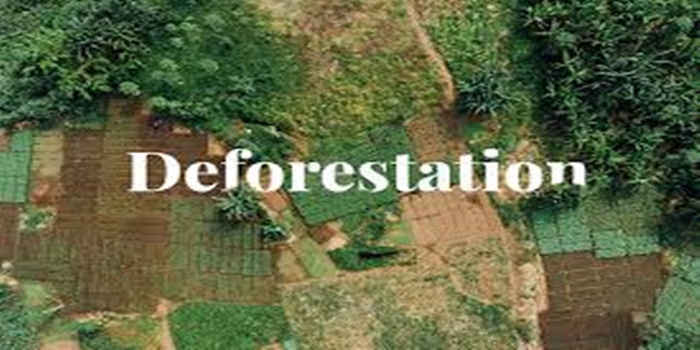In this article, we discussed the meaning of deforestation, the causes, furthermore we also talked about the effect
Definition
Deforestation is the purposeful clearing of forested land. Throughout history and into modern times, forests have been razed to make space for agriculture and animal grazing, and to obtain wood for fuel, manufacturing, and construction.
Deforestation is the permanent removal of trees and forests to make way for other uses. It’s a major environmental issue that contributes to climate change and biodiversity loss.
The Causes of Deforestation
Expansion of agricultural land
One of the leading causes of deforestation is the expansion of agricultural land, accounting for more than 70% of deforestation rates. Agricultural practices, such as clearing vast areas of forest for farming, logging, and fuelwood use, are primary activities that contribute significantly to deforestation. Both subsistence farming, where farmers grow crops to feed their families, and commercial agriculture, which produces crops for export or domestic use, are responsible for hundreds to thousands of hectares of forest being taken down.
Livestock grazing
Livestock grazing, particularly for meat production, is also a significant cause of deforestation. Farmers often clear vast areas of land to create grazing pastures for their livestock, contributing to the loss of forested land. The degradation of soil resulting from overgrazing often also leads to repeated clearing and deforestation.
Logging and wood harvesting
Logging and wood harvesting are among the leading causes of deforestation across the world, especially in North America and Russia. Forests are valuable resources that provide timber products for construction, furniture, and paper. Unfortunately, this often leads to unsustainable logging practices that destroy millions of hectares of forested land every year.
Urbanization and expansion of cities
Urbanization and the expansion of cities have a significant impact on deforestation, contributing to the destruction of forested land across the globe. As urban areas grow, they require more resources to sustain their populations, increasing demand for products like beef and agricultural goods. This demand fuels deforestation both directly—through the conversion of forested land into housing or agricultural land—and indirectly—by increasing pressure on forests to provide resources.
Human population growth
As the world’s population continues to grow, the demand for food, housing, and natural resources also increases. This directly impacts deforestation as the need for more land for agriculture and settlements fuels the conversion of forests into farmland and urban areas.
Increased need for resources
The increased need for resources is a major driver of deforestation. The demand for wood products as well as agricultural products, including palm oil and soybeans, have contributed to unsustainable levels of deforestation.
Over-exploitation of natural resources
Over-exploitation of natural resources is a major cause of deforestation. This occurs when humans extract more resources than the environment can replenish naturally, leading to the depletion of natural resources such as minerals, fossil fuels, and timber. Activities that contribute to this type of deforestation include mining, logging, and oil and gas extraction.
Intensive crop cultivation
Intensive crop cultivation is another leading cause of deforestation worldwide. This farming practice involves the cultivation of crops on a large scale, with high inputs of fertilizers, pesticides, and other chemical additives. This method is often used to produce crops such as soybeans and palm oil, which are in high demand for use in animal feed production, particularly livestock, and various other industries.
Expansion of manufacturing and industrial sites
The expansion of manufacturing and industrial sites is one of the major drivers of deforestation worldwide. Industrialization has brought about an increase in the demand for resources such as wood, minerals, and other raw materials. Additionally, biomass power generation, which uses organic materials derived from forests to generate energy and is the primary energy source in some regions, can be another cause of deforestation if sourced unsustainably.
The Effect of Deforestation
Deforestation, the clearing of forests, has many negative effects on the environment, including:
Climate change: Deforestation contributes to global warming by releasing carbon dioxide into the atmosphere. Trees absorb carbon dioxide and release oxygen, which helps regulate the Earth’s temperature.
Loss of habitat: Deforestation destroys the homes of many species of plants and animals, leading to extinction.
Soil erosion: Without trees to protect the soil, it becomes more susceptible to erosion from wind and water.
Desertification: Deforestation can lead to desertification in some areas.
Water cycle disruption: This can disrupt the water cycle.
Air pollution: it can make air pollution worse.
Depletion of natural resources: it reduces the availability of timber, medicinal plants, nuts, fruit, and game.
Displacement of indigenous people: it can displace indigenous people who live in forests.
Solution to Deforestation
There are many solutions to it, including reforestation, reducing consumption, and supporting Indigenous communities.
Reforestation
Planting trees in areas that have been it.
Supporting projects that restore forests
Reforestation can help restore soil fertility and biodiversity
Reduce consumption Buy fewer products that use palm oil, Consume less meat, and Reduce paper use.
Support Indigenous communities Protect the rights of Indigenous communities, Support sustainable forest practices, and Integrate Indigenous knowledge into forest management.
Offset your carbon footprint
Offset carbon emissions that can’t be avoided
This can help you reach carbon neutrality
Use technology
Use satellite imaging and remote sensing to monitor forests
This can help enforce the laws and track illegal activity
Create policies Create policies that support sustainable practices and Provide economic incentives for preserving forests.
Conclusion
Deforestation is the purposeful clearing of forested land. Throughout history and into modern times, forests have been razed to make space for agriculture and animal grazing, and to obtain wood for fuel, manufacturing, and construction.


